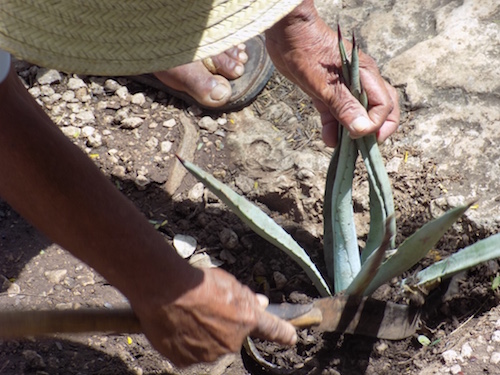Kurt Kremitzki, who is in his final year of studying biological and agricultural engineering at Texas A&M, visited a Mayan community in the Yucatan this spring to help design irrigation systems. He was one of 14 aspiring IT professionals to receive a 2016 Linux Foundation Training (LiFT) scholarship, announced last month.
Kurt was inspired to take the project a step further when he realized that a system of Raspberry Pis with cell phone connectivity and open source software could create an automated irrigation system based on weather reports and sensor readings. He is now working with a local university in Mexico to develop such a system, which is just the first step in his dream of using technology to find new ways to meet the world’s growing food needs.

Kurt Kremitzki: I was introduced to Linux in the era of Red Hat Linux 9, but I thought it *was* Linux, and when “Enterprise” was added I stopped using it. Several years ago, I picked up Ubuntu and started using it full time. More recently, besides use at home, I applied what knowledge I have of Linux to a robotics competition, using the Raspberry Pi, hosted by the American Society of Agricultural & Biological Engineers in New Orleans last year. When a similar competition was assigned to an introductory Control Theory class I took last semester, the professor opted to have me assist the TA and all my classmates in teaching basic Linux skills and Python programming to do a simple maze following project.
Linux.com: Why did you become a developer?
Kurt: Originally graduating high school at 16, I chose to explore my talent working with computers by studying Computer Science, but found that studying it for its own sake was uninspiring. I didn’t finish but ended up with a job as a developer anyway, until several years ago. I decided to go back to school for Biological & Agricultural Engineering, where I could use my computer skills to solve pressing challenges, like the need to feed almost 10 billion people by 2050.
Linux.com: How do you use Linux now?
Kurt: This spring, I visited an impoverished Mayan community in the Yucatan to assist in design and repair of backyard irrigation systems. I was inspired to work further with them, and one particular way I want to use Linux to make a difference involves my (hopeful) senior design project plans.
When I visited that community, the potential benefit of Linux, and in particular something like the Raspberry Pi, was obvious. Although water was abundant, knowledge about agriculture has largely been lost as a result of the near-slavery conditions of the hacienda system, and so a simple base of a Raspberry Pi and cell phone network connectivity could serve both as an educational platform and the heart of an irrigation automation system. However, since technical knowledge in the village is limited, my team and I would have to work with the local university to (a) prepare open sourced teaching tools on how to use and repair our (also open source) irrigation automation system and (b) come up with an extremely resilient system that is easy to repair (e.g., create a simple, dedicated SD card flasher from another Raspberry Pi and a button.)
Using wirelessly gathered sensor data and local weather readings, the irrigation system could efficiently use water, and also serve as a guide for planting and harvesting, making the best use of two of our most precious resources: time, and the free energy of the sun. The local university has been working on backyard irrigation systems with small Mayan villages for the last 6 years, and there is tremendous potential to expand this program, both for the Mayan villagers and the students at the university.
Linux.com: How can Linux help solve the problem of food scarcity?
Kurt: Closely related to Linux and the notion of open source software is the idea of empowerment. One of the most pressing issues in my field is the need to feed 9-10 billion people by the year 2050, and because of inefficiencies in our global food system, that means an increase in production of 70 to 100 percent. We may need to double our global production with no new cropland being discovered (in fact it’s being eaten up by cities) and less water being available.

Instead, new developments in Linux, like nascent drone/UAV technology, things like Automotive Grade Linux, and the general ethos of collaboration will be essential. Linux and its associated tools and ecosystem will be pivotal in tackling the challenges of tomorrow, and in empowering people across the world to unlock the full potential of their computer resources to advance mankind, whether it’s in the agricultural sector or otherwise.
Linux.com: How do you plan to use your LiFT scholarship?
Kurt: Although I have quite a bit of experience using Linux as a programmer, there are gaps in my knowledge, as it’s mostly the result of searching for the solution to problems as I come across them. As a developer-turned-biosystems engineering student, I’ve realized this isn’t enough. The problems in my field, while vast and staggering in scope, are about 95 percent human and 5 percent technical. By seeking out formal training, I can cover the gaps in my knowledge, make myself more employable once I graduate, and most importantly, I can spend less time worrying about how technology works, and more time worrying about how technology can help solve human problems.
Linux.com: How will the scholarship help you achieve your dream of helping to solve the world’s looming food scarcity crisis?
Kurt: The estimated doubling of food production that will be needed to feed the world in 2050 is likely not going to come from the corn and soybean fields of Illinois or Iowa. Trying to get more productivity from that style of farming is a little like getting blood from a stone. Instead, some of the places most likely to contribute will be mountainous regions and small villages of China, Latin America, and Africa, where huge tractors and industrial farming practices don’t make physical or economic sense.
Advances in things like agricultural drones have huge potential to empower subsistence farmers; Linux and The Linux Foundation are already forging ahead in that field with work like the Dronecode Project, an open source UAV platform. Besides drones, bringing the wealth of the world’s knowledge in the form of Internet connectivity will have a huge impact for rural farmers’ productivity and for the happiness of rural people in general. Large strides are being made in this domain as well with projects like Rhizomatica in Mexico and Guifi.net in Spain where Linux is once again front and center.
There’s no shortage of work to be done to make the world a better place; Linux and the open source philosophy behind it is one of the best force multipliers to making things happen. With Linux, I can have complete control of computing resources from the physical layer to the presentation layer; I can choose to make and use technology that will help the most people.
Interested in learning more about starting your IT career with Linux? Check out our free ebook “A Brief Guide To Starting Your IT Career In Linux.” [Download Now]


